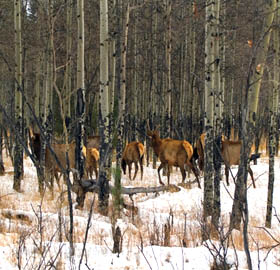
Madison Valley ranchers are well aware of this abundance. The immense elk herds graze forage reserved for cattle and push through freshly mended fences like a snowplow through a drift. Throw the wolf and its killing of cattle into the mix, and you find conflict. By definition, these factors make wildlife a liability to landowners who secure a living running livestock.
As it turns out, land management practices that grow high quality grass for cows are the same practices that provide high quality wildlife habitat. Ranchers are doing elk a favor and are helping to keep the Madison Valley an ecological jewel. Fortunately, valley ranchers enjoy seeing wildlife. Watching a large elk herd move across the open landscape can be breathtaking—an experience one can’t find in many other places. But ranchers don’t enjoy carrying the financial hardship that abundant wildlife brings. Seeking change, ranchers began talking about these issues.
How could they turn this ecological abundance into something other than financial hardship? In their meetings, the idea of forming a tourism company surfaced. Madison Valley Expeditions, LLC (MVE) was born.
MVE escorts guests to private ranches where they participate in a wide variety of activities. A typical wintertime wildlife viewing tour begins on a ranch with huge, open spaces where large elk herds roam and wolves may be glimpsed. Then, the conversation shifts to agriculture and how that industry fits amidst ecological abundance. Agriculture is still the financial backbone of many ranches, but the open spaces and wildlife are what draw people’s attention. Balancing these needs is the job of the resource steward. The day ends with guests working through a case study. If they were ranch owners and wolves were killing their cows, how would they best manage this difficult situation?
For their efforts, ranchers are compensated by MVE based on the number of visitor-days they host. The more guests, the longer the visit, the more they get paid. Ranchers produce publicly valued open spaces and habitat, and MVE handles administration, financing, and marketing of the business. Economy of scale allows for minimal business overheads, while guests have access to multiple ranches and hundreds of thousands of acres of wild things in wild places.
With this compensation model, ranchers have an incentive, not only to maintain open spaces and manage their lands well, but also to create additional guest experiences on their properties such as bird watching, hiking, biking, horseback riding, cross country skiing, or exploring archeological sites. In this way, guests experience the New Wild West in ways not available to them otherwise.
Madison Valley Expeditions likely cannot have enough economic impact to offset the losses ranchers incur from elk grazing their grass or wolves running weight off their cattle, but it can help. On the day an excited rancher calls and wants us to bring eager guests out because he’s seen wolves and elk on his place is the day we make wildlife an asset and take a giant leap toward preserving the wildness of the Madison Valley.



